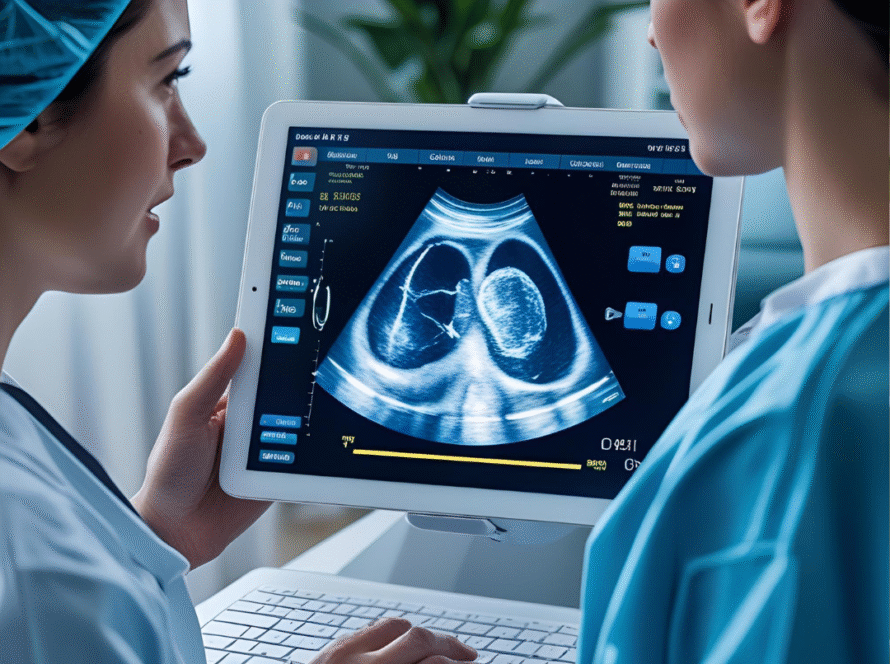
Post-surgical monitoring shapes patient recovery. If problems like infection or bleeding are not caught early, recovery slows and health risks rise. AI-powered mobile imaging now brings diagnostic tools directly to the patient. This makes detection faster. It also means patients do not have to make frequent trips to the hospital.
The Evolution of Post-Surgical Monitoring
In the past, most post-surgical monitoring happened at the hospital or clinic. Patients waited for appointments and test results. Many people who could not travel found this stressful. Now, AI-driven mobile imaging allows scanning at home or at the bedside. With instant image review, healthcare teams can spot issues and act quickly.
Key Technologies in AI Mobile Imaging
Bedside Imaging and AI Data Processing
Portable imaging devices such as mobile ultrasound and digital X-ray can scan patients at home or in clinics. AI software checks these scans for warning signs of infection, bleeding, or swelling. If there is an abnormal result, it alerts the care team right away.
Secure Cloud Delivery and EHR Integration
Mobile imaging systems use secure cloud platforms to upload results for the care team. A radiologist checks every scan and adds the report within two hours. Results go directly into the patient’s electronic health record. This helps every member of the care team act fast.
Patient and Provider Benefits of AI Mobile Imaging
Below is a table showing how AI-powered mobile imaging helps both patients and healthcare teams:
| Benefit Category | Description |
| Reduced Hospital Visits | Imaging at home lowers infection risk and stress for patients |
| Rapid Turnaround | Imaging results are ready in 15 minutes and final reports in under 2 hours |
| Early Complication Detection | AI points out problems like infection, swelling, or bleeding |
| Instant Communication | Cloud-based results reach all care team members at once |
| Clinical Accuracy | Board-certified radiologists confirm the AI findings |
| Lower Patient Anxiety | Patients get answers fast so they feel less worry |
Clinical Applications in Post-Surgical Monitoring
Wound and Soft Tissue Assessment
AI-powered mobile imaging checks surgical wounds for infection, reopening, or swelling. If the scan finds a problem, doctors can change wound care right away. This reduces the risk of major issues.
Implant and Bone Healing Checks
Doctors need to see if surgical implants or bones stay in place after surgery. AI checks these X-rays and alerts the team if anything is wrong. Quick action means better recovery.
Edema and Hematoma Identification
Fluid buildup and blood pooling can cause harm after surgery. AI software checks each scan for these signs. Doctors then treat the problem before it gets worse.
How Serenity.ai Mobile Imaging Supports Better Post-Surgical Outcomes
Rapid At-Home Imaging Workflow
After surgery, a patient can book visits from mobile imaging teams. At each visit, scans happen at home. AI checks images for infection, swelling, or bleeding. If there is a concern, the care team gets a notice, and a radiologist reviews the findings within two hours. This keeps the patient safe at home and lowers readmissions.
Enhanced Clinical Confidence
AI works with the radiologist to catch changes in the surgery area. The radiologist double-checks all results. This teamwork helps prevent mistakes and lets doctors respond quickly if there is a problem.
Key Terms in Post-Surgical Monitoring
Here are important terms used in post-surgical monitoring with AI-powered imaging:
- Wound assessment means checking for infection or wound opening
- Edema detection means finding fluid buildup near the surgery site
- Hematoma identification means finding internal bleeding
- Implant position review checks that implants stay in place
- DVT monitoring means screening for blood clots after surgery
- Soft tissue evaluation means looking for swelling or abscess
Overcoming Challenges in AI Mobile Imaging
There are a few challenges in using AI mobile imaging. Patient data stays safe with secure cloud systems. Healthcare staff get training to use the equipment and read the reports. These systems fit with the way doctors and nurses already work, so care continues smoothly.
Future Trends in Mobile Post-Surgical Care
AI will soon play a bigger role in patient care after surgery. Researchers are working on systems that warn about problems before symptoms appear. Mobile imaging may link with wearable devices for full-time health tracking. This could help create recovery plans that fit each patient’s needs and improve results after surgery.
Wrapping Up
AI-powered mobile imaging changes how doctors care for patients after surgery. It brings fast scans and results to the patient’s home. Problems get spotted early, so treatment starts quickly. This helps patients feel safe and makes recovery smoother.


